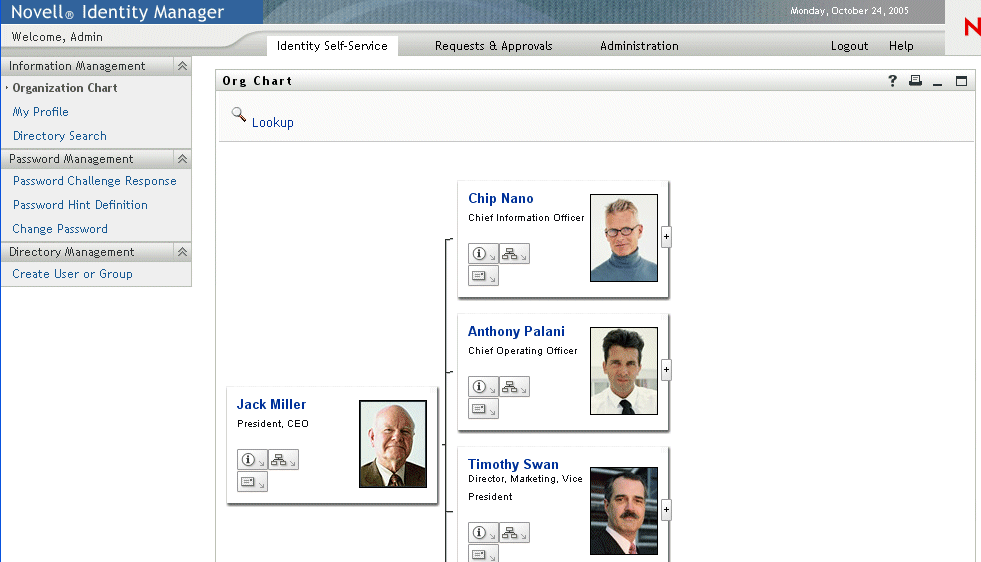18.1 About Org Chart
The Org Chart portlet allows end users to view and browse a graphical representation of the hierarchical relationships between objects in the identity vault. For example, you can define Org Chart portlets that show the hierarchy of:
-
An organization (such as employees and managers)
-
A group’s membership (such as all of the employees in a group)
-
Devices assigned to a user (such as cell phones and laptops)
The default configuration of the Identity Manager user application Identity Self-Service tab includes an Organization Chart action. This action is an Org Chart portlet configured to show relationships among user objects in the identity vault. The following example shows how the default Org Chart portlet renders this relationship (using sample data).

Built-in links The Org Chart portlet includes these built-in links.
|
Link |
Description |
|---|---|
|
|
Allows the user to navigate to the next upper level. This is only available when viewing a relationship where the parent and child entities are the same. |

|
Launches the Detail portlet. This built-in link is configurable via the org chart layout preferences described in Org chart layout preferences |

|
Displays a list of org charts. Lets users choose an org chart to view. This list of org charts is dynamic. It displays other org charts that share the same parent entity type. For example, if you are viewing a manager/employee org chart (the parent entity is user) and you click this icon, then the list of org charts you can view will only contain relationships where the parent entity is also user. This built-in link is configurable via the org chart layout preferences described in Org chart layout preferences |

|
Launches an email tool to:
This built-in link is configurable via the org chart layout preferences described in Org chart layout preferences |
|
|
The Lookup Link allows users to perform entity searches. The searches result in the found entity becoming the top node of the chart displayed. |

|
Lets users drill down to the next level. |
For more information about adding and restricting the built-in links on your org charts, see Org chart layout preferences.
18.1.1 About Org Chart Relationships
The Org Chart portlet displays relationships that are defined in the directory abstraction layer. The following relationships are available after the Identity Manager user application is installed.
-
Group’s membership
-
Manager-Employee
-
User Groups
To learn more about creating or modifying Org Chart relationships, see Section 4.0, Configuring the Directory Abstraction Layer.
NOTE:Dynamic groups are not fully supported by the org chart portlet. You cannot define a dynamic group as the Parent entity of a relationship, but you can define a dynamic group as the child entity in a relationship.
18.1.2 About Org Chart display
By default, the org chart displays within the portlet’s frame in an area defined by the Portlet Width and Portlet Height preferences. If the contents require more than the defined area, the portlet borders will expand and the page height and width will do so as well. Users can get a fully displayed org chart by clicking the maximize icon available through the portlet’s title bar. (The org chart is displayed in fully maximized mode, by default, when launched from the Detail portlet.)
User images By default, the org chart layout for the User object includes the User Photo attribute. However, if your identity vault does not include this attribute or it is not populated, the org chart ignores this attribute at runtime. If you store your photos in a different location, you can configure the org chart to display those photos instead.
For more information, see Section 18.2.3, Dynamically loading images.